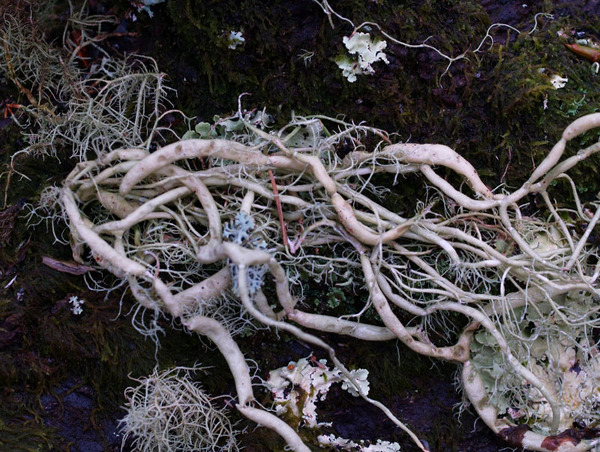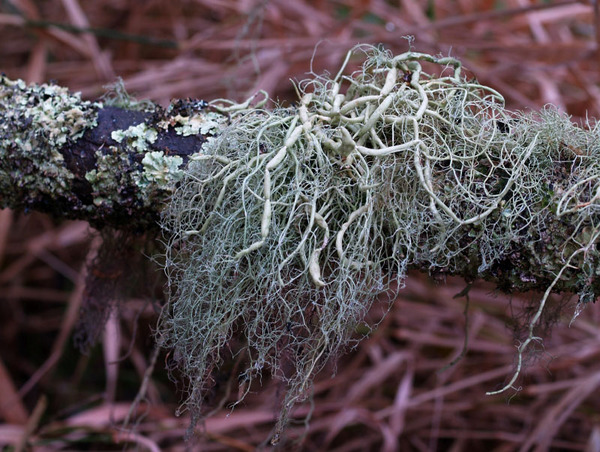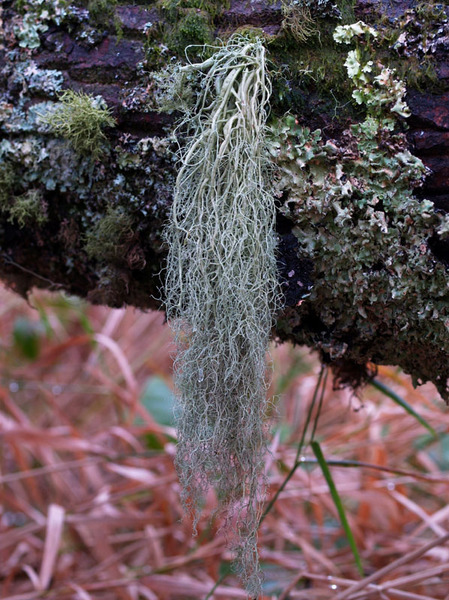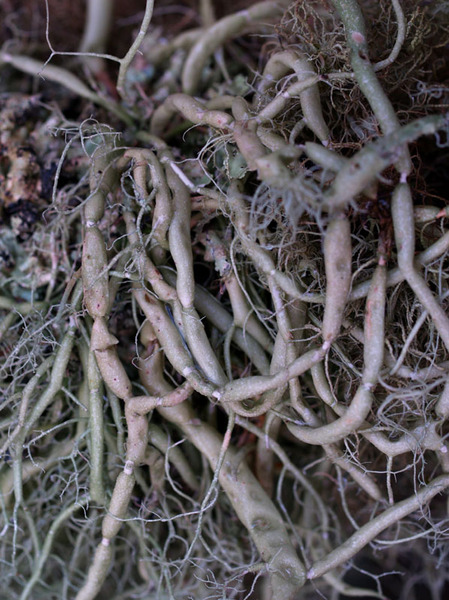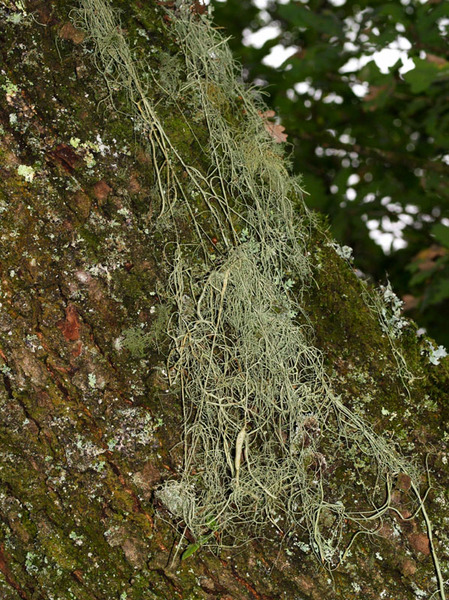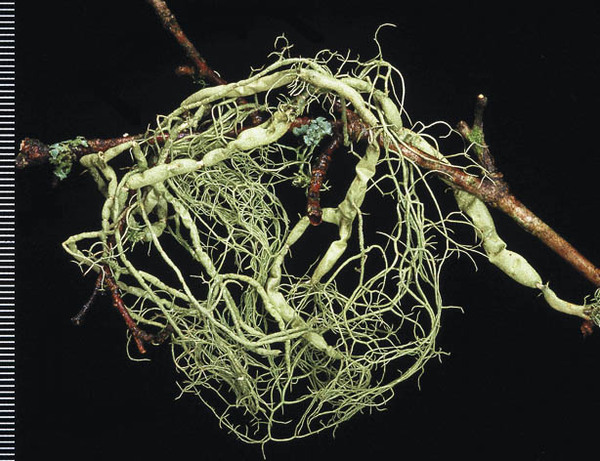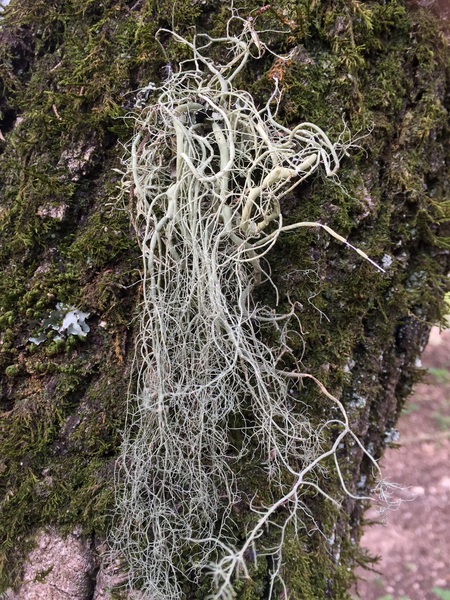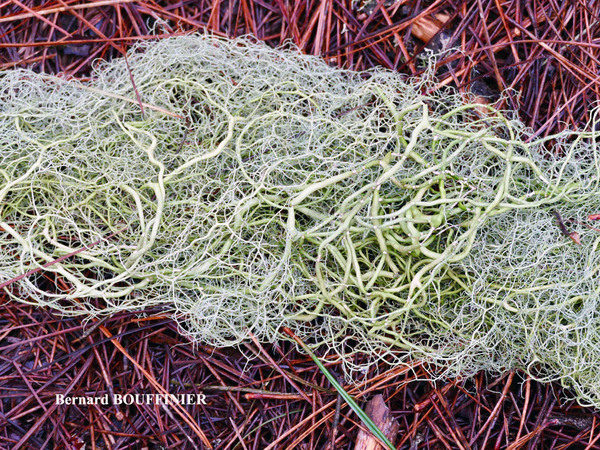Usnea articulata (L.) Hoffm.
Deutschl. Fl., 2: 133, 1796. Basionym: Lichen articulatus L. - Sp. Pl., 2: 1156, 1753.
Synonyms: Usnea articulata subsp. intestiniformis (Ach.) Motyka; Usnea articulata subsp. mediterranea Motyka; Usnea barbata var. articulata (L.) Ach.
Distribution: N - Ven, Lomb, Emil (Fariselli & al. 2020). C - Tosc, Laz (Roca & al. 1998), Abr, Sar (Loi & al. 2000, Zedda 2002b). S - Camp (Aprile & al. 2003b), Pugl (Nimis & Tretiach 1999), Bas (Potenza & al. 2014), Cal (Puntillo 1995, 1996, Brackel & Puntillo 2016), Si (Nimis & al. 1994, Ottonello & Salone 1994, Ottonello & Romano 1997, Ottonello & al. 2006b, 2011, Ottonello & Puntillo 2009).
Description: Thallus fruticose-filamentous, pale green, long-pendent, to >1 m long, sparingly branched at base, more richly branched towards apices, with a few flexuose lateral branches. Main branches up to 5 mm wide, cylindrical, smooth, the older parts constricted and inflated between constrictions (sausage-like), the surface usually smooth to sparsely papillose, sometimes with scattered comma-like pseudocyphellae. Cortex relatively thin, (5-7 % of the branch diameter); medulla white, very lax and cottony-arachnoid, especially in the inflated parts; central axis white, sometimes visible in the constrictions of old branches. Apothecia unknown in Italian material. Photobiont chlorococcoid. Spot tests: cortex K-, C-, KC-, P-; medulla K-, C-, KC-, P+ red. Chemistry: cortex with usnic acid; medulla with fumarprotocetraric (main) and protocetraric acid (accessory).Note: a Mediterranean-Macaronesian lichen with subtropical affinities, found on the branches of ancient trees in humid forests of Southern Italy, more frequent in Sardinia and Calabria, certainly extinct in Northern Italy. The recent record from Tuscany by Pasquinelli & al. (2009), judging from the picture, is wrong. It is included in the Italian red list of epiphytic lichens as “Vulnerable” (Nascimbene & al. 2013c).
Growth form: Fruticose filamentous
Substrata: bark
Photobiont: green algae other than Trentepohlia
Reproductive strategy: mainly asexual, by thallus fragmentation
Most common in areas with a humid-warm climate (e.g. most of Tyrrenian Italy)
Commonnes-rarity: (info)
Alpine belt: absent
Subalpine belt: absent
Oromediterranean belt: absent
Montane belt: extremely rare
Submediterranean belt: absent
Padanian area: absent
Humid submediterranean belt: extremely rare
Humid mediterranean belt: extremely rare
Dry mediterranean belt: absent
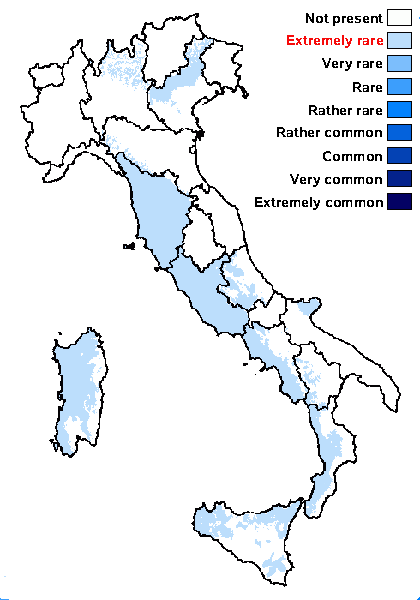
Predictive model
Herbarium samples
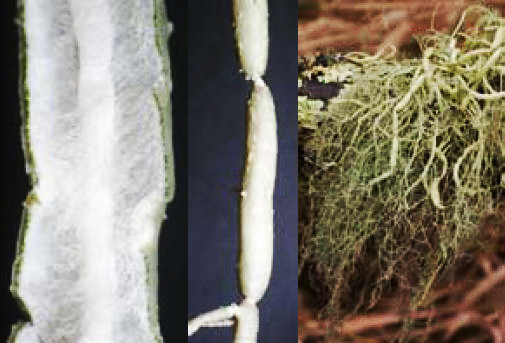
Tiiu Tõrra; Owner: Tiiu Tõrra - Institute of Ecology and Earth Sciences, University of Tartu, Estonia
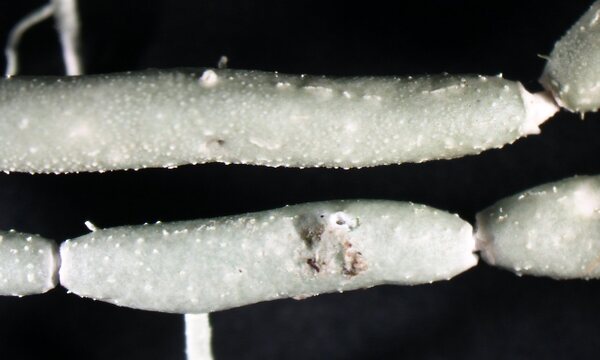
Tiiu Tõrra; Owner: University of Tartu
Great Britain, Devon, Darmoor National Park, Lydford
2007/04/24
Inflated,sausage-like segments of branches
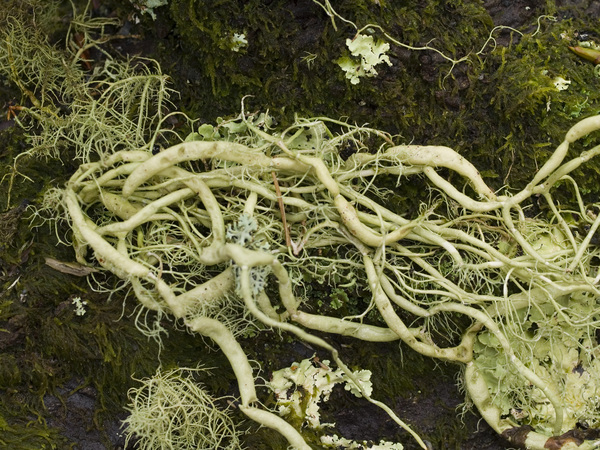
Andres Saag; Owner: University of Tartu
Great Britain, Devon, Darmoor National Park, Lydford
2006/10/06
Inflated branches
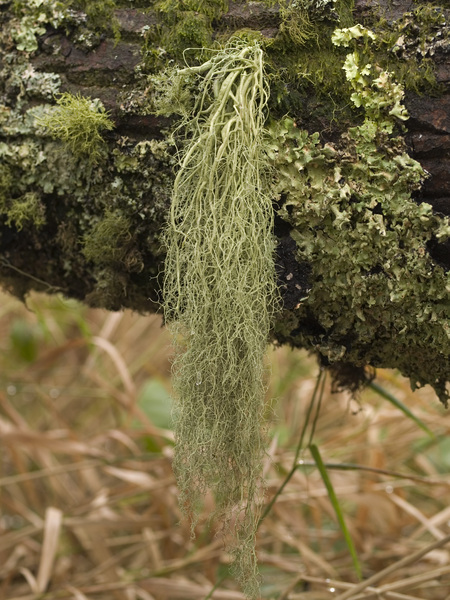
Andres Saag; Owner: University of Tartu
Great Britain, Devon, Darmoor National Park, Lydford
2006/10/06
Pendulous thallus

Tiiu Tõrra; Owner: Tiiu Tõrra - Institute of Ecology and Earth Sciences, University of Tartu, Estonia

Tiiu Tõrra; Owner: Tiiu Tõrra - Institute of Ecology and Earth Sciences, University of Tartu, Estonia

Tiiu Tõrra; Owner: Tiiu Tõrra - Institute of Ecology and Earth Sciences, University of Tartu, Estonia
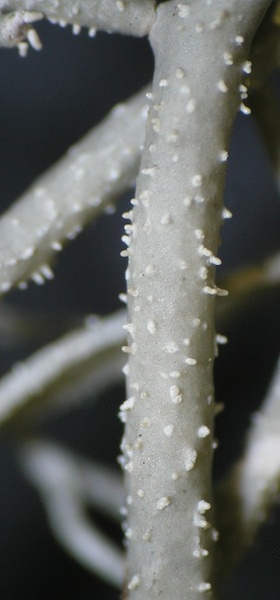
Tiiu Tõrra; Owner: Tiiu Tõrra - Institute of Ecology and Earth Sciences, University of Tartu, Estonia

Tiiu Tõrra; Owner: Tiiu Tõrra - Institute of Ecology and Earth Sciences, University of Tartu, Estonia
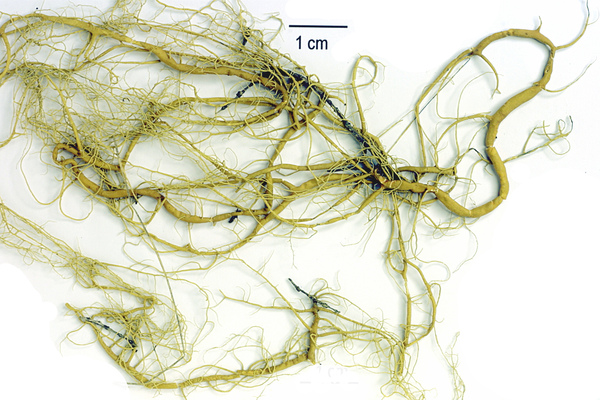

Felix Schumm - CC BY-SA 4.0
[2710], Apanien, Kanarische Inseln, Gran Canaria, 7 km südlich von Lanzarote, Felswand an der Straße nach Tejeda oberhalb von Cuevas del Corcho, Nebelzone, ca. 1300 m Schumm 03.01.1978


Felix Schumm - CC BY-SA 4.0
[2710], Apanien, Kanarische Inseln, Gran Canaria, 7 km südlich von Lanzarote, Felswand an der Straße nach Tejeda oberhalb von Cuevas del Corcho, Nebelzone, ca. 1300 m Schumm 03.01.1978
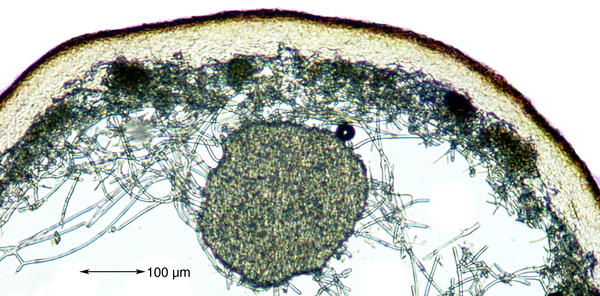

Felix Schumm - CC BY-SA 4.0
[2710], Apanien, Kanarische Inseln, Gran Canaria, 7 km südlich von Lanzarote, Felswand an der Straße nach Tejeda oberhalb von Cuevas del Corcho, Nebelzone, ca. 1300 m Schumm 03.01.1978
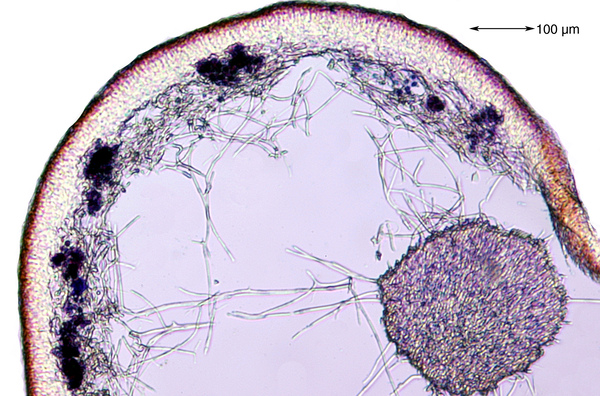

Felix Schumm - CC BY-SA 4.0
[2710], Apanien, Kanarische Inseln, Gran Canaria, 7 km südlich von Lanzarote, Felswand an der Straße nach Tejeda oberhalb von Cuevas del Corcho, Nebelzone, ca. 1300 m Schumm 03.01.1978
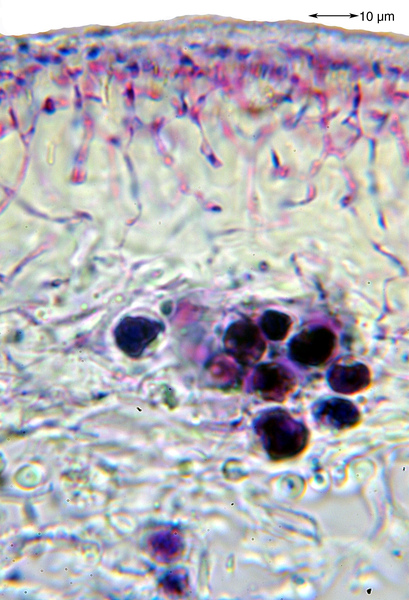

Felix Schumm - CC BY-SA 4.0
[2710], Apanien, Kanarische Inseln, Gran Canaria, 7 km südlich von Lanzarote, Felswand an der Straße nach Tejeda oberhalb von Cuevas del Corcho, Nebelzone, ca. 1300 m Schumm 03.01.1978
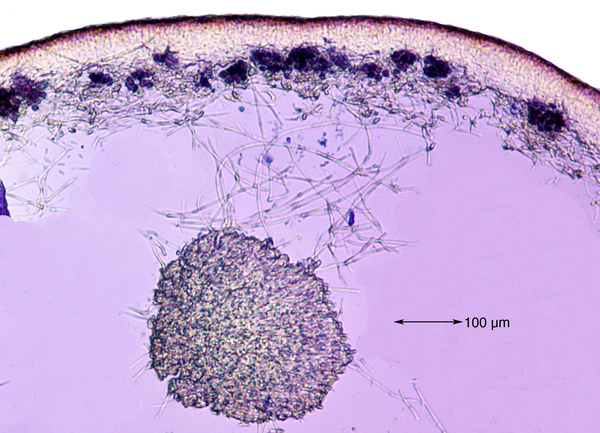

Felix Schumm - CC BY-SA 4.0
[2710], Apanien, Kanarische Inseln, Gran Canaria, 7 km südlich von Lanzarote, Felswand an der Straße nach Tejeda oberhalb von Cuevas del Corcho, Nebelzone, ca. 1300 m Schumm 03.01.1978
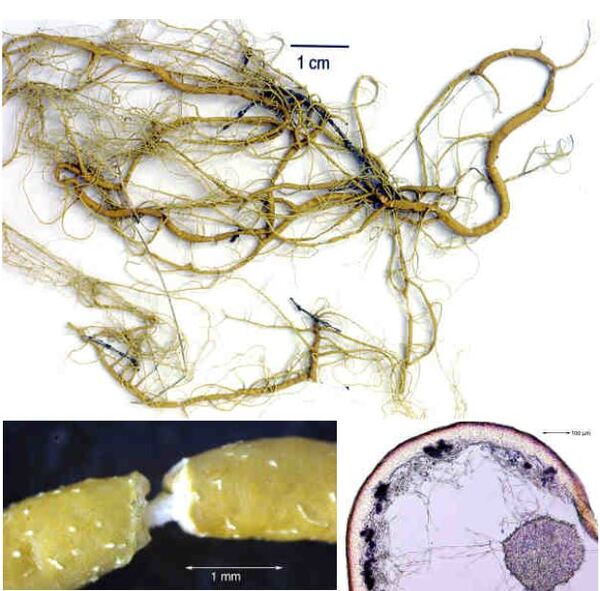

Felix Schumm – CC BY-SA 4.0
Image from: F. Schumm (2008) - Flechten Madeiras, der Kanaren und Azoren. Beck, OHG - ISBN: 978-3-00-023700-3

Courtesy Danièle et Olivier Gonnet - Source: https://www.afl-lichenologie.fr/Photos_AFL/Photos_AFL_U/Usnea_articulata.htm
France, 9/10/2010 - sous le col de Vergio D84, alt : 1300 m - Corse -
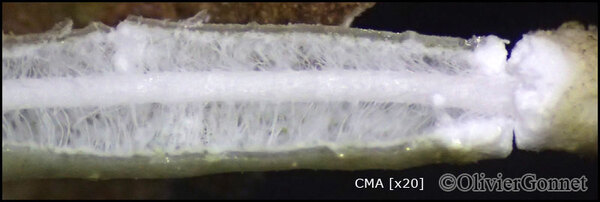
Courtesy Danièle et Olivier Gonnet - Source: https://www.afl-lichenologie.fr/Photos_AFL/Photos_AFL_U/Usnea_articulata.htm
France, 9/10/2010 - sous le col de Vergio D84, alt : 1300 m - Corse -

Bernard Bouffinier - Source: http://www.lichensmaritimes.org/index.php?task=fiche&lichen=323&lang=en
France, Brasparts
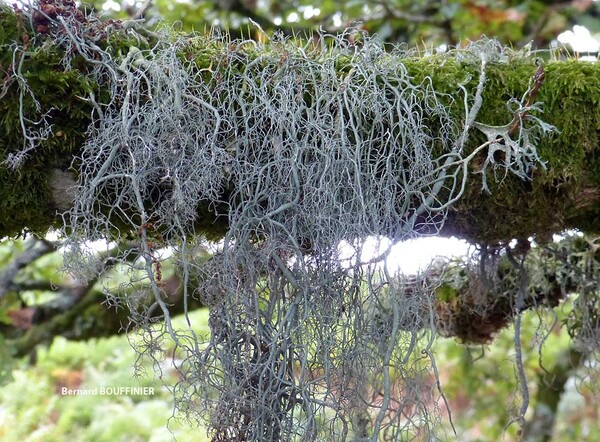
Bernard Bouffinier - Source: http://www.lichensmaritimes.org/index.php?task=fiche&lichen=323&lang=en
France, Brennilis
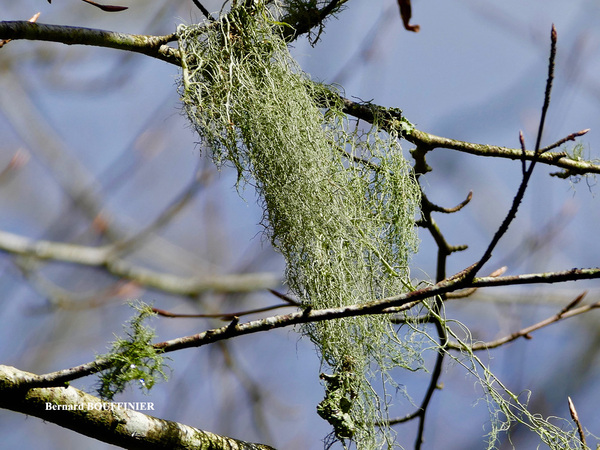
Bernard Bouffinier - Source: http://www.lichensmaritimes.org/index.php?task=fiche&lichen=323&lang=en
France, Cranou

Bernard Bouffinier - Source: http://www.lichensmaritimes.org/index.php?task=fiche&lichen=323&lang=en
France, Cranou
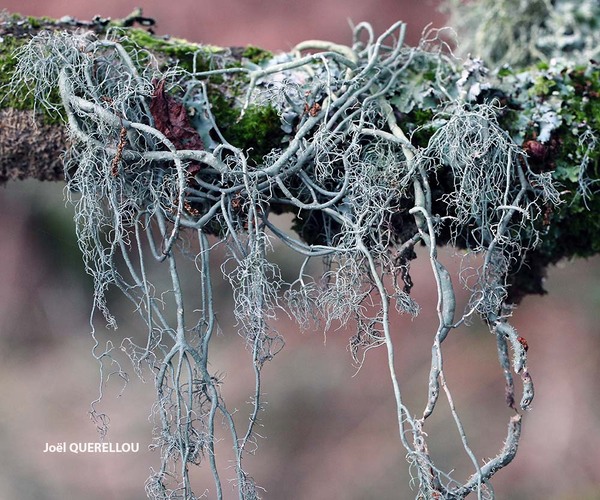
Joel Querellou - Source: http://www.lichensmaritimes.org/index.php?task=fiche&lichen=323&lang=en
France, St. Herbot
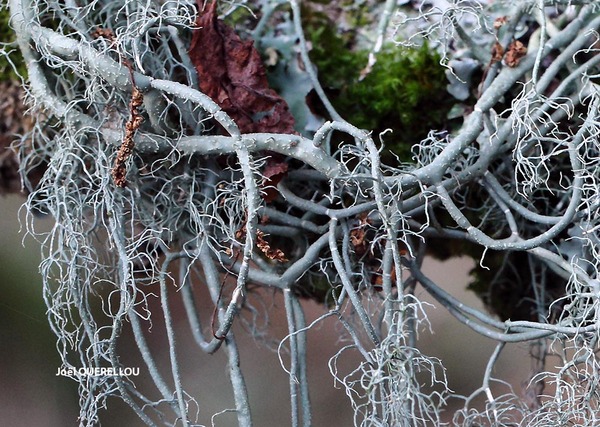
Joel Querellou - Source: http://www.lichensmaritimes.org/index.php?task=fiche&lichen=323&lang=en
France, St. Herbot
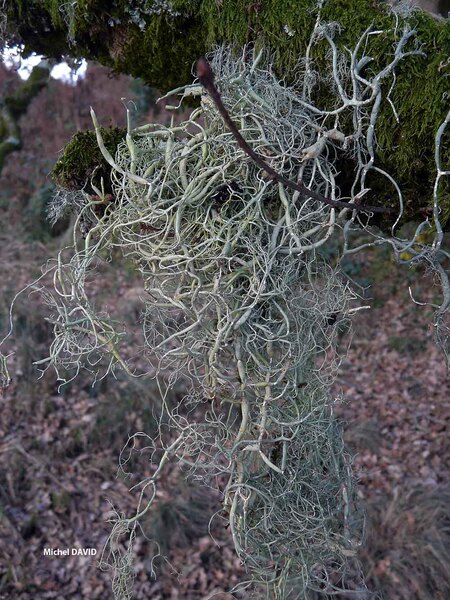
Michel David - Source: http://www.lichensmaritimes.org/index.php?task=fiche&lichen=323&lang=en
France, St. Herbot
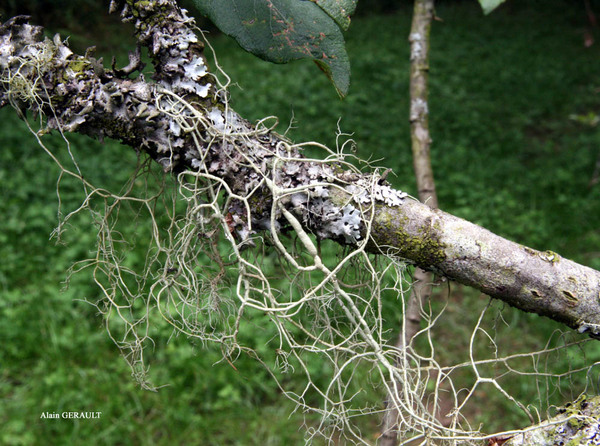
Alain Gerault - Source: http://www.lichensmaritimes.org/index.php?task=fiche&lichen=323&lang=en
France, Brennilis
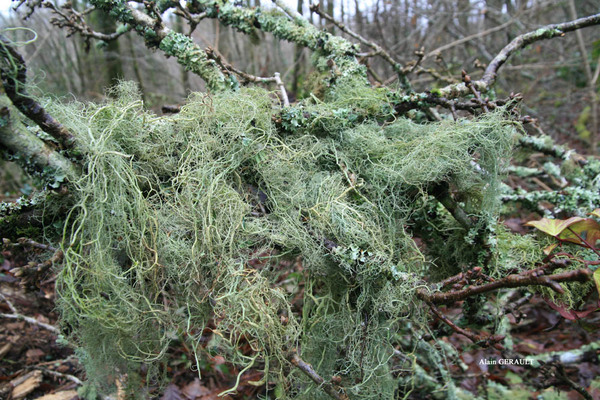
Alain Gerault - Source: http://www.lichensmaritimes.org/index.php?task=fiche&lichen=323&lang=en
France, Cranou
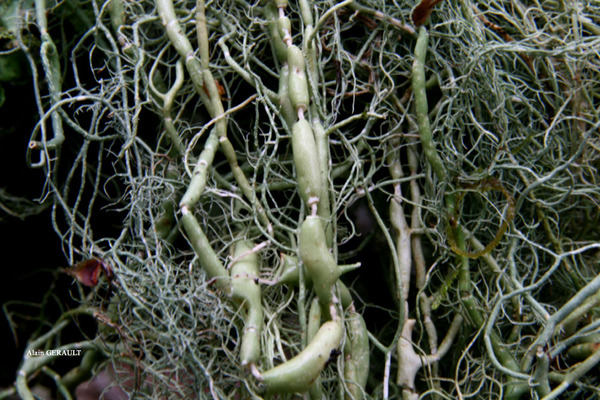
Alain Gerault - Source: http://www.lichensmaritimes.org/index.php?task=fiche&lichen=323&lang=en
France, Cranou
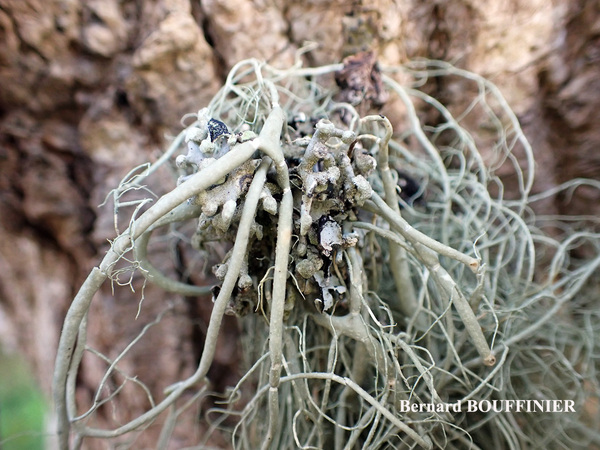
Bernard Bouffinier - Source: http://www.lichensmaritimes.org/index.php?task=fiche&lichen=323&lang=en
France, Commana
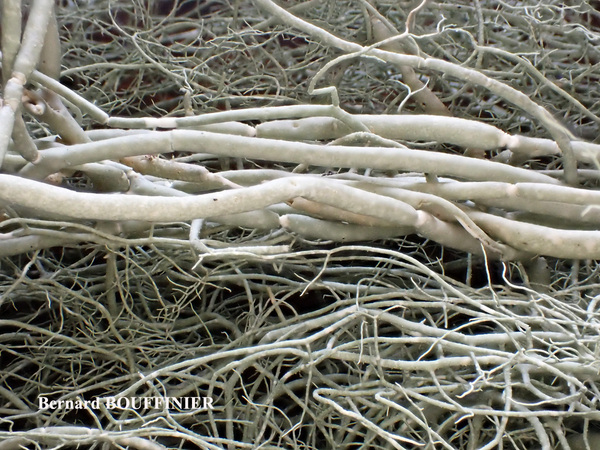
Bernard Bouffinier - Source: http://www.lichensmaritimes.org/index.php?task=fiche&lichen=323&lang=en
France, Sant Mikel
Growth form: Fruticose filamentous
Substrata: bark
Photobiont: green algae other than Trentepohlia
Reproductive strategy: mainly asexual, by thallus fragmentation
Most common in areas with a humid-warm climate (e.g. most of Tyrrenian Italy)
Commonnes-rarity: (info)
Alpine belt: absent
Subalpine belt: absent
Oromediterranean belt: absent
Montane belt: extremely rare
Submediterranean belt: absent
Padanian area: absent
Humid submediterranean belt: extremely rare
Humid mediterranean belt: extremely rare
Dry mediterranean belt: absent

Predictive model
| Herbarium samples |

Tiiu Tõrra; Owner: Tiiu Tõrra - Institute of Ecology and Earth Sciences, University of Tartu, Estonia

Tiiu Tõrra; Owner: University of Tartu
Great Britain, Devon, Darmoor National Park, Lydford
2007/04/24
Inflated,sausage-like segments of branches

Andres Saag; Owner: University of Tartu
Great Britain, Devon, Darmoor National Park, Lydford
2006/10/06
Inflated branches

Andres Saag; Owner: University of Tartu
Great Britain, Devon, Darmoor National Park, Lydford
2006/10/06
Pendulous thallus

Tiiu Tõrra; Owner: Tiiu Tõrra - Institute of Ecology and Earth Sciences, University of Tartu, Estonia

Tiiu Tõrra; Owner: Tiiu Tõrra - Institute of Ecology and Earth Sciences, University of Tartu, Estonia

Tiiu Tõrra; Owner: Tiiu Tõrra - Institute of Ecology and Earth Sciences, University of Tartu, Estonia

Tiiu Tõrra; Owner: Tiiu Tõrra - Institute of Ecology and Earth Sciences, University of Tartu, Estonia

Tiiu Tõrra; Owner: Tiiu Tõrra - Institute of Ecology and Earth Sciences, University of Tartu, Estonia


Felix Schumm - CC BY-SA 4.0
[2710], Apanien, Kanarische Inseln, Gran Canaria, 7 km südlich von Lanzarote, Felswand an der Straße nach Tejeda oberhalb von Cuevas del Corcho, Nebelzone, ca. 1300 m Schumm 03.01.1978


Felix Schumm - CC BY-SA 4.0
[2710], Apanien, Kanarische Inseln, Gran Canaria, 7 km südlich von Lanzarote, Felswand an der Straße nach Tejeda oberhalb von Cuevas del Corcho, Nebelzone, ca. 1300 m Schumm 03.01.1978


Felix Schumm - CC BY-SA 4.0
[2710], Apanien, Kanarische Inseln, Gran Canaria, 7 km südlich von Lanzarote, Felswand an der Straße nach Tejeda oberhalb von Cuevas del Corcho, Nebelzone, ca. 1300 m Schumm 03.01.1978


Felix Schumm - CC BY-SA 4.0
[2710], Apanien, Kanarische Inseln, Gran Canaria, 7 km südlich von Lanzarote, Felswand an der Straße nach Tejeda oberhalb von Cuevas del Corcho, Nebelzone, ca. 1300 m Schumm 03.01.1978


Felix Schumm - CC BY-SA 4.0
[2710], Apanien, Kanarische Inseln, Gran Canaria, 7 km südlich von Lanzarote, Felswand an der Straße nach Tejeda oberhalb von Cuevas del Corcho, Nebelzone, ca. 1300 m Schumm 03.01.1978


Felix Schumm - CC BY-SA 4.0
[2710], Apanien, Kanarische Inseln, Gran Canaria, 7 km südlich von Lanzarote, Felswand an der Straße nach Tejeda oberhalb von Cuevas del Corcho, Nebelzone, ca. 1300 m Schumm 03.01.1978


Felix Schumm – CC BY-SA 4.0
Image from: F. Schumm (2008) - Flechten Madeiras, der Kanaren und Azoren. Beck, OHG - ISBN: 978-3-00-023700-3

Courtesy Danièle et Olivier Gonnet - Source: https://www.afl-lichenologie.fr/Photos_AFL/Photos_AFL_U/Usnea_articulata.htm
France, 9/10/2010 - sous le col de Vergio D84, alt : 1300 m - Corse -

Courtesy Danièle et Olivier Gonnet - Source: https://www.afl-lichenologie.fr/Photos_AFL/Photos_AFL_U/Usnea_articulata.htm
France, 9/10/2010 - sous le col de Vergio D84, alt : 1300 m - Corse -

Bernard Bouffinier - Source: http://www.lichensmaritimes.org/index.php?task=fiche&lichen=323&lang=en
France, Brasparts

Bernard Bouffinier - Source: http://www.lichensmaritimes.org/index.php?task=fiche&lichen=323&lang=en
France, Brennilis

Bernard Bouffinier - Source: http://www.lichensmaritimes.org/index.php?task=fiche&lichen=323&lang=en
France, Cranou

Bernard Bouffinier - Source: http://www.lichensmaritimes.org/index.php?task=fiche&lichen=323&lang=en
France, Cranou

Joel Querellou - Source: http://www.lichensmaritimes.org/index.php?task=fiche&lichen=323&lang=en
France, St. Herbot

Joel Querellou - Source: http://www.lichensmaritimes.org/index.php?task=fiche&lichen=323&lang=en
France, St. Herbot

Michel David - Source: http://www.lichensmaritimes.org/index.php?task=fiche&lichen=323&lang=en
France, St. Herbot

Alain Gerault - Source: http://www.lichensmaritimes.org/index.php?task=fiche&lichen=323&lang=en
France, Brennilis

Alain Gerault - Source: http://www.lichensmaritimes.org/index.php?task=fiche&lichen=323&lang=en
France, Cranou

Alain Gerault - Source: http://www.lichensmaritimes.org/index.php?task=fiche&lichen=323&lang=en
France, Cranou

Bernard Bouffinier - Source: http://www.lichensmaritimes.org/index.php?task=fiche&lichen=323&lang=en
France, Commana

 Index Fungorum
Index Fungorum
 GBIF
GBIF
